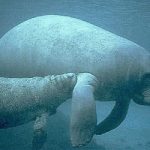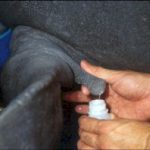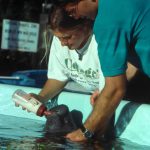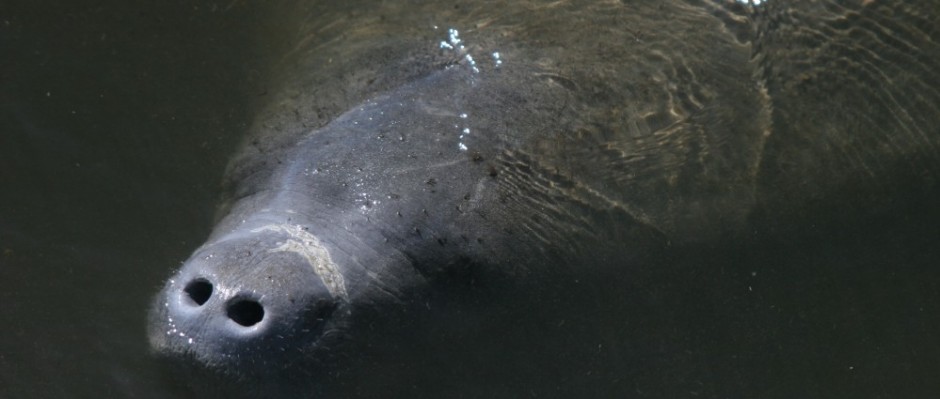Very little is known about manatee reproductive physiology, in particular the energetic needs of calves and maternal energy transfer. These  are parameters that cannot be easily measured in free-ranging animals and we are therefore forced to examine animals in captivity and extrapolate that information to free-ranging animals. One technique that has been applied successfully to the measurement of milk transfer and calf energetics is the use of doubly labeled water (DLW).
are parameters that cannot be easily measured in free-ranging animals and we are therefore forced to examine animals in captivity and extrapolate that information to free-ranging animals. One technique that has been applied successfully to the measurement of milk transfer and calf energetics is the use of doubly labeled water (DLW).
 This study was the first attempt to quantify the energetics of the suckling period for the West Indian manatee and took place at The Living Seas of Epcot Center. Over the years, data has accumulated on growth rates of orphaned calves and some captive born animals, yet we had no understanding of transfer of energy and how calves utilized it. Growth rate of the calf in the present study was almost double that previously published and all of the parameters measured in the present study were unquestionably influenced by this incredible rate of mass gain. This calf was an example of an animal that was raised under near-ideal conditions, with low foraging costs, no thermoregulatory demands, and a high availability of food. This preliminary study has expanded our knowledge of this critical period in the life of a manatee and will both improve our capabilities in the captive care of this species and our understanding of their natural history and biology.
This study was the first attempt to quantify the energetics of the suckling period for the West Indian manatee and took place at The Living Seas of Epcot Center. Over the years, data has accumulated on growth rates of orphaned calves and some captive born animals, yet we had no understanding of transfer of energy and how calves utilized it. Growth rate of the calf in the present study was almost double that previously published and all of the parameters measured in the present study were unquestionably influenced by this incredible rate of mass gain. This calf was an example of an animal that was raised under near-ideal conditions, with low foraging costs, no thermoregulatory demands, and a high availability of food. This preliminary study has expanded our knowledge of this critical period in the life of a manatee and will both improve our capabilities in the captive care of this species and our understanding of their natural history and biology.
Suckling duration (114 to 156 sec) and frequency (every 49-62 min) remained relatively constant throughout the  ~560 day lactation period. Milk consumption rose from 4.0 l d-1 (at age 55 d) to a maximum of 12.2 l d-1 (at age 245 d), before declining to 2.4 l d-1 (at age 550 d). Concurrent with this decline in milk intake was an increased intake of romaine lettuce. By 550 days, the calf was consuming 18 kg d-1 of lettuce. These data represent the first attempt to understand and quantify the energetics of the suckling period for this species. It appears that the combination of low metabolism with a relatively high energy intake (high fat milk and large volume) resulted in the deposition of large amounts of lipid and a sustained high rate of growth (~0.7 kg d-1) through the relatively long nursing period of this species.
~560 day lactation period. Milk consumption rose from 4.0 l d-1 (at age 55 d) to a maximum of 12.2 l d-1 (at age 245 d), before declining to 2.4 l d-1 (at age 550 d). Concurrent with this decline in milk intake was an increased intake of romaine lettuce. By 550 days, the calf was consuming 18 kg d-1 of lettuce. These data represent the first attempt to understand and quantify the energetics of the suckling period for this species. It appears that the combination of low metabolism with a relatively high energy intake (high fat milk and large volume) resulted in the deposition of large amounts of lipid and a sustained high rate of growth (~0.7 kg d-1) through the relatively long nursing period of this species.
